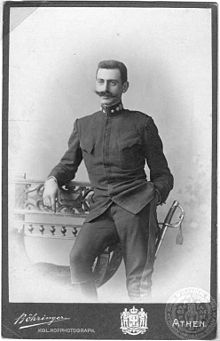Pavlos Melas
You can help expand this article with text translated from the corresponding article in Greek. (June 2021) Click [show] for important translation instructions.
|
Pavlos Melas Παῦλος Μελᾶς | |
|---|---|
 Pavlos Melas in uniform. | |
| Nickname(s) | Kapetan Mikis Zezas Καπετάν Μίκης Ζέζας |
| Born | 29 March 1870 Marseille, Second French Empire |
| Died | 13 October 1904 (aged 34) Statitsa, Ottoman Empire (now Melas, Greece) |
| Buried | |
| Allegiance | |
| Service | |
| Years of service | 1891–1904 |
| Rank | Second lieutenant |
| Battles / wars | |
| Alma mater | Hellenic Army Academy |
| Children | 2 |
| Relations | Michail Melas (father) Vasileios Melas (brother) Anna Mela-Papadopoulou (sister) Natalia Mela (granddaughter) Ion Dragoumis (brother-in-law) |
| Other work | Member of the Ethniki Etaireia Member of the HMC |
Pavlos Melas (Greek: Παύλος Μελάς, Pávlos Melás; 29 March 1870 – 13 October 1904) was a Greek revolutionary and artillery officer of the Hellenic Army. He participated in the Greco-Turkish War of 1897 and was amongst the first Greek officers to join the Macedonian Struggle.
Early life and career
[edit]Melas was born in Marseilles, France, the son of Michail Melas who was elected MP for Attica and mayor of Athens and brother of Vassileios Melas who was also an officer of the Hellenic Army. The Melas family was of Greek haute bourgeois descent.[1] Pavlos' father was a wealthy merchant from Epirus.[2] At an early age Pavlos moved to Athens to study, and later joined the Army, graduating from the Hellenic Army Academy as an artillery lieutenant in 1891. In 1892, he married Natalia Dragoumi, the daughter of Kastorian politician Stephanos Dragoumis and sister of Ion Dragoumis. In 1895, the couple had a son named Michael and a daughter, Zoe.
He became member 25 of the Ethniki Etaireia and participated in the Greco-Turkish War of 1897.
Armed action
[edit]Melas, with the cooperation of his brother-in-law Ion Dragoumis, the consul of Greece in the then Ottoman occupied Monastir (now Bitola), Kottas Christou, and Germanos Karavangelis, metropolitan bishop of Kastoria, tried to raise money for the economic support of Greek efforts in Macedonia. After the Ilinden-Preobrazhenie uprising, he decided to enter Macedonia in June 1904, to assess the situation and to see if there is any possibility of establishing a military unit to fight the Bulgarian Komitadjis (Internal Macedonian Revolutionary Organization, IMRO) and the Ottoman Turks.
Death
[edit]In July 1904 (under the alias "Captain Mikis Zezas", Καπετάν Μίκης Ζέζας), he reentered Macedonia with a small unit of men and fought against the VMRO until 13 October 1904 when he was killed after being surrounded by Ottoman forces in the village of Siatista. The village with coordinates 40° 42' N 021° 16' E has been renamed Melas in his honour, after joining Greece.
After his death, Greek efforts became more intense, resulting in the interception of Bulgarian Komitadji efforts, especially in West and Central Macedonia, which was annexed by Greece after the Balkan Wars.
Legacy
[edit]He is considered to be a symbol of the Greek Struggle for Macedonia and many of his personal belongings can be seen in the Museum of the Macedonian Struggle in Thessaloniki and Pavlos Melas Museum in Kastoria.
His granddaughter Natalia Mela was a distinguished sculptor.
Gallery
[edit]-
A photograph of Pavlos Melas as a second lieutenant in the Greek Army.
-
Pavlos Melas as a second lieutenant in the Greek Army. Portrait by Georgios Jakobides.
-
In Macedonomachos uniform
References
[edit]- ^ Keridis, Dimitris; Kiesling, John Brady (2020). Thessaloniki: A City in Transition, 1912–2012. Routledge. p. 54. ISBN 978-0-429-51366-4.
- ^ George C. Papavizas (2006). Claiming Macedonia: The Struggle for the Heritage, Territory and Name of the Historic Hellenic Land, 1862-2004. McFarland. p. 58. ISBN 978-1-4766-1019-1.
External links
[edit]- 1870 births
- 1904 deaths
- 19th-century Greek military personnel
- Eastern Orthodox Christians from Greece
- Eastern Orthodox Christians from France
- Military personnel from Athens
- Greek military personnel of the Macedonian Struggle
- Hellenic Army officers
- Greek military personnel killed in action
- Greek nationalists
- Dragoumis family
- Greek expatriates in France
- Greek Freemasons




